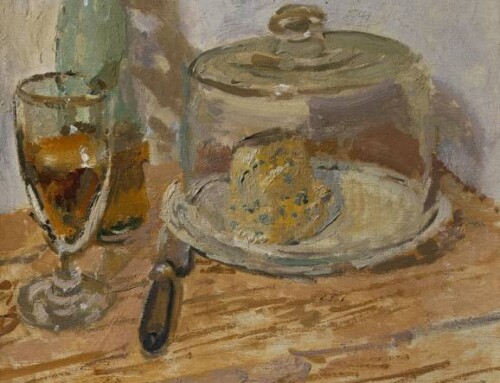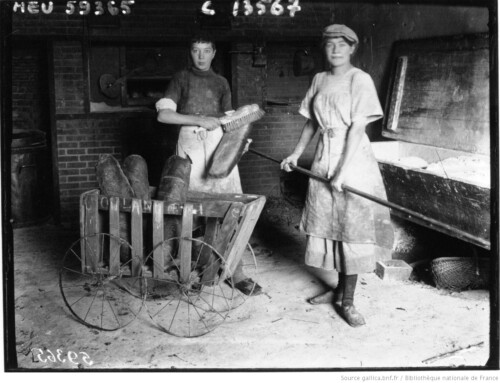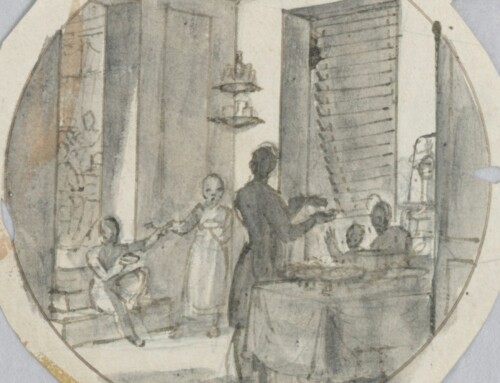Absinthe, brandy, Camembert, candy, chocolate, cognac, Cointreau, cookies, Coulommiers cheese, lemon soda, Sauternes — advertising for many food items in France from the late nineteenth to the early twentieth centuries used the Pierrot character.
The commedia dell’arte character known variously as Piero and Pedrolino (with Pagliaccio as an earlier version) was introduced to France in the sixteenth century by a group of Italian traveling actors who reached the court of Henri III. The French soon created a character named Pierrot who is at times amiable, cruel, greedy, honest, melancholic, mocking, naïve, romantic, sly, thieving, vulnerable, a coward, a criminal, a dreamer, a lunatic, a rascal, a vanquisher of evil, a victim, to list just a few of the possibilities. Pierrot went from being a secondary figure in fairground performances to being a major character in Parisian theaters. Pierrot appears in Molière’s Dom Juan (1665), but it is in the next century that Pierrot would gain more ground partly through interpretations done by the actors Antoine Belloni (active early 1700s) and Jean-Baptiste Hamoche (active 1712-1718, 1721-1732). In nineteenth-century Paris two actors who brought Pierrot to new heights were Jean-Baptiste-Gaspard Deburau (1796-1846) and Paul Legrand (1816-1898). Performances at the Théâtre des Funambules in Paris inspired Théophile Gautier (1811-1872), Jules Champfleury (1821-1889), Gustave Flaubert (1821-1880), George Sand (1804-1876), and others to write a few scenes. In 1855 Paris also saw the ballet-pantomime Pierrot le clown created by Jacques Offenbach (1819-1880).
In the play Le monde renversé by Alain René Le Sage (1668-1747) and Jacques-Philippe d’Orneval (died 1766), first performed at the 1718 Foire de Saint Laurent and published in 1721, the character Arlequin wishes for saucisson, Pierrot wishes for wine, and the foods magically appear. Delighted, Arlequin then wishes for some macarons and cookies, while Pierrot wishes for a dindon tout cuit, all of which magically appear. Pierrot goes on to wish for du laitage, with Arlequin wishing for some cheese and small tarts — of course these items appear out of thin air as well.
The Pierrot character was also developed in non-theater works such as Pierrot lunaire : rondels bergamasques (1884) by Albert Giraud and Baudelaire’s 1855 essay “De l’essence du rire.” Darker notions of the Pierrot character appear in the novels Pierrot (1860) by Henri Rivière and Braves gens (1886) by Jean Richepin. Artists working in France such as Claude Gillot (1673-1722), Antoine Watteau (1684-1721), Honoré Daumier (1808-1879), Auguste Bouquet (1810-1846), Gustave Courbet (1819-1877), Gustave Doré (1832-1883), Picasso (1881-1973), and Juan Gris (1887-1927) envisioned their own Pierrots.
▀▄▀▄▀▄
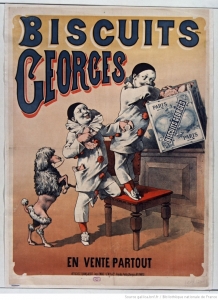
Biscuits Georges. En vente partout : [affiche]. 1885. Bibliothèque nationale de France. → https://gallica.bnf.fr/ark:/12148/btv1b9016245q

Firmin Bouisset (1859-1925). Goûtez et comparez chocolat Poulain : [affiche]. Circa 1898. Ville de Paris, Bibliothèque Forney / Roger-Viollet. → https://bibliotheques-specialisees.paris.fr/ark:/73873/pf0000817265

PAL / Jean de Paléologue (1855-1942). Cusenier Peach brandy, liqueur de pêches : [affiche]. Circa 1900. Bibliothèque nationale de France. → https://catalogue.bnf.fr/ark:/12148/cb39840074c

Nicolas Tamagno (1862-19??). Liqueur Cointreau Angers : [affiche]. 1920. Ville de Paris, Bibliothèque Forney / Roger-Viollet. → https://bibliotheques-specialisees.paris.fr/ark:/73873/pf0000830226
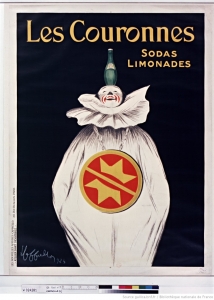
Leonetto Cappiello (1875-1942). Les Couronnes, sodas, limonades : [affiche]. 1924. Bibliothèque nationale de France. → https://gallica.bnf.fr/ark:/12148/btv1b9006006n
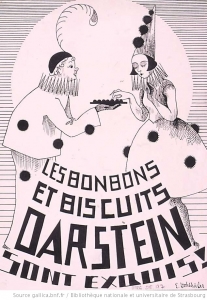
Les bonbons et biscuits Darstein sont exquis ! / E. Wohlhuter. 19?? Bibliothèque nationale de France / Bibliothèque nationale et universitaire de Strasbourg → https://gallica.bnf.fr/ark:/12148/btv1b10220915w
▀▄▀▄▀▄
To view more Pierrot-related food product packaging and advertising:
- Camembert made in Calvados, Meuse, Randonnai, Touraine, Ardennes, Bourgogne, Noiron, Ligueil, Haute-Vienne, Isigny, Sandillon, Saintonge, Cozes, La Marne (note the Pierrette character on the packaging for Camembert made in Franche-Comté, Lozère, Poitou, Anjou, Saintonge, Aumale) → https://www.camembert-museum.com/pages/thematiques/theme-litteraire/personnages-de-fiction-ii.html
- Pierrot Gourmand chocolatier-confiseur → https://www.imagexpertise.com/imagenum/imagenums/gourmand.htm
- Guignolet Cointreau → https://www.mfa.org/collections/object/guignolet-cointreau-569075
- Pierrot Absinthe → https://absinthemuseum.auvers.over-blog.com/2017/07/pierrot-absinthe.html
- Absinthe Pierrot → https://absinthemuseum.auvers.over-blog.com/2017/07/absinthe-pierrot.html
- Cognac Otard → https://www.thevintageposter.com/poster-detail/?inv=4451
- Pierrot-Gauchotte Coulommiers → https://www.camembert-museum.com/pages/historiques-region-est/pierrot-gauchotte-55.html
- Kina-Lilas au vin de Sauternes → https://www.affiches-anciennes.fr/affiche-ancienne-affiche-kina-lilas-au-vin-de-sauternes-vintage-poster-bank-theme-boissons-reproduction-numerique-daffiche.html
▀▄▀▄▀▄
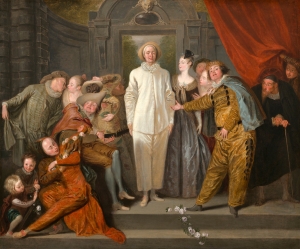
Antoine Watteau (1684-1721), The Italian Comedians, probably 1720, oil on canvas, Samuel H. Kress Collection 1946.7.9. National Gallery of Art, Washington, D.C. → https://www.nga.gov/collection/art-object-page.32687.html#overview

Carle Vanloo (1705-1765) and Antoine Watteau (1684-1721). Deux Pierrot sur une console : [estampe] / Pierrot et Scapin. 1726. Bibliothèque nationale de France. → https://catalogue.bnf.fr/ark:/12148/cb43839037d
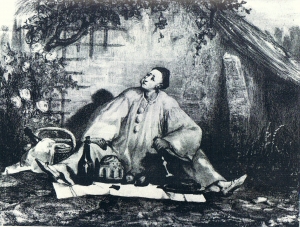
J.-G. Deburau as Pierrot Gourmand by Auguste Bouquet. Copy of a photo in the Harvard Theatre Collection. Circa 1830. Public domain in the United States via Wikimedia Commons. → https://commons.wikimedia.org/wiki/File:J.-G._Deburau_as_Pierrot_Gourmand.jpg
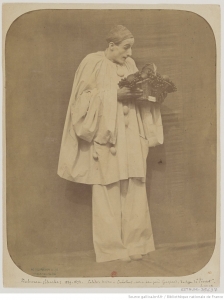
Adrien Alban Tournachon (1825-1903). Charles Deburau : Pierrot à la corbeille de fruits : [photographie] / Ad. Tournachon jeune [et Félix Nadar]. 1854-1855. Bibliothèque nationale de France. → https://catalogue.bnf.fr/ark:/12148/cb45054235c
▀▄▀▄▀▄
References & Suggested Reading
Attinger, Gustave. L’esprit de la commedia dell’arte dans le théâtre français. Slatkine, 1981.
Besson, Agnès. Pierrot gourmand : un siècle de création sucrée. Cherche midi, 2002.
Bouquet, Auguste. Le Repas de Pierrot / Revue des Peintres. 1834. The British Museum, London. → https://www.britishmuseum.org/research/collection_online/collection_object_details.aspx?objectId=3341192&partId=1&searchText=auguste+bouquet+&page=0. Accessed April 2018.
Champfleury, Jules. Pierrot, valet de la mort : pantomime en sept tableaux. 1846.
Clair, Jean, ed. The Great Parade: Portrait of the Artist as Clown. Yale UP, 2004.
Courbet, Gustave. Le Bras noir. 1856. L’Illustration, Journal universel, No. 678, Volume XXVII, February 23, 1856. → https://www.gettyimages.com/detail/illustration/pierrot-and-black-arm-le-bras-noir-pantomime-by-fernand-stock-graphic/766364695. Accessed April 2018.
Daumier, Honoré. Un Pierrot déplumé. / No. 9. 1847. Musée Carnavalet, Paris. → https://parismuseescollections.paris.fr/fr/musee-carnavalet/oeuvres/un-pierrot-deplume-ndeg9#infos-principales. Accessed April 2018.
Doré, Gustave. Pierrot grimaçant. N.d., Musée d’Art moderne et contemporain, Strasbourg. → https://expositions.bnf.fr/orsay-gustavedore/grand/dor_251.htm. Accessed April 2018.
Flaubert, Gustave and Louis Bouilhet. Pierrot au sérail : pantomime en six actes, suivie de l’apothéose de Pierrot dans le paradis de Mohamet (circa 1847). In Œuvres complètes de Gustave Flaubert, VII. Paris: Club de l’Honnête homme, 1972.
Frecker, Paul. “Paul Legrand.” The Library of Nineteenth-Century Photography. → https://www.19thcenturyphotos.com/Paul-Legrand-122039.htm Accessed April 2018.
Gautier, Théophile. Pierrot posthume. 1847.
Gérôme, Jean-Léon. The Duel After the Masquerade. 1857-1859. The Walters Art Museum → https://art.thewalters.org/detail/12697/the-duel-after-the-masquerade/. Accessed April 2018.
Gillot, Claude and Jacques Gabriel Huquier. Pierrot and Scaramouche show the portrait of Harlequin. N.d., The Metropolitan Museum of Art, New York City. → https://www.metmuseum.org/art/collection/search/369533. Accessed April 2018.
“Goutez et Comparez. Chocolat Poulain.” 1898. Les collections du Musée national de l’Education. → https://www.reseau-canope.fr/musee/collections/fr/museum/mne/goutez-et-comparez-chocolat-poulain/d52d4fc9-9460-4b45-bc2d-b7c15030bbdb. Accessed April 2018.
Gris, Juan. Le Pierrot au livre. 1924. Tate Galleries, United Kingdom. → https://www.tate.org.uk/art/artworks/gris-pierrot-with-book-t06814. Accessed April 2018.
Haskell, Francis. “The Sad Clown: Some Notes on a 19th century Myth.” French 19th Century Painting and Literature, with Special Reference to the Relevance of Literary Subject-Matter to French Painting, ed. Ulrich Finke. New York: Harper & Row, 1972. Pp.2-16.
Jones, Louisa E. Sad Clowns and Pale Pierrots: Literature and the Popular Comic Arts in 19th-Century France. Kentucky: French Forum, 1984.
Le Sage, Alain René and Jacques-Philippe d’Orneval. Le monde renversé : pièce d’un acte par Lesage et d’Orneval, représenté à la Foire de Saint Laurent 1718. Paris: E. Ganeau, 1721.
Lust, Annette. From the Greek Mimes to Marcel Marceau and Beyond: Mimes, Actors, Pierrots, and Clowns: A Chronicle of the Many Visages of Mime in the Theatre. Scarecrow Press, 2002.
Nicoll, Allardyce. The World of Harlequin: A Critical Study of the Commedia Dell’Arte. CUP Archive, 1987.
Palacio, Jean de. Pierrot fin-de-siècle ou les métamorphoses d’un masque. Paris: Séguier, 1990.
Paul-Marcetteau, Agnès. « Les auteurs du théâtre de la foire à Paris au XVIIIe siècle. » Bibliothèque de l’école des chartes. 1983, tome 141, livraison 2. pp. 307-335.
Pène du Bois, Guy. Pierrot Tired. Circa 1929. National Gallery of Art, Washington, D.C. → https://www.nga.gov/collection/art-object-page.195811.html. Accessed April 2018.
Perle, George. The Right Notes: Twenty-three Selected Essays by George Perle on Twentieth-Century Music. Pendragon Press, 1995. (See “Pierrot lunaire” pp.33-38)
Picasso, Pablo. Pierrot. 1918. Museum of Modern Art, New York City. → https://www.moma.org/collection/works/78427. Accessed April 2018.
Prasad, Pratima and Susan McCready, eds. Novel Stages: Drama and the Novel in Nineteenth-Century France. University of Delaware Press, 2007.
Rex, Walter E. The Attraction of the Contrary: Essays on the Literature of the French Enlightenment. Cambridge UP, 1987.
Sand, George. Pierrot enlevé. 1849.
Storey, Robert F. Pierrots on the Stage of Desire: Nineteenth-Century French Literary Artists and the Comic Pantomime. Princeton UP, 2014.
Watteau, Jean-Antoine. Pierrot Content. Circa 1712. Museo Nacional Thyssen-Bornemisza, Madrid. → https://www.museothyssen.org/en/collection/artists/watteau-jean-antoine/pierrot-content. Accessed April 2018.
– – – . The Italian Comedians (alternate title: The Italian Comedians in a Park). Circa 1720. The J. Paul Getty Museum, Los Angeles. → https://www.getty.edu/art/collection/objects/258873/jean-antoine-watteau-the-italian-comedians-french-about-1720/. Accessed April 2018.
